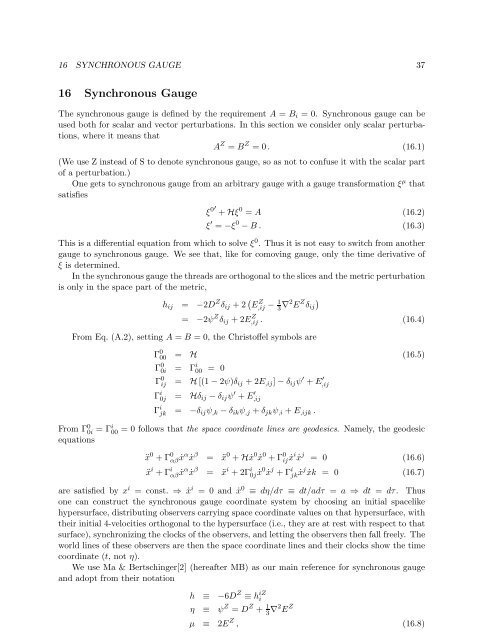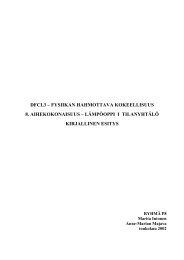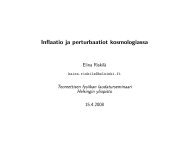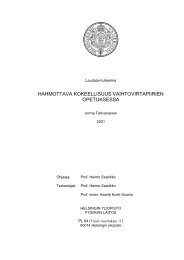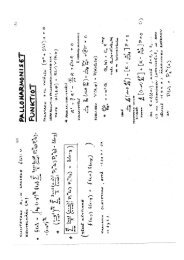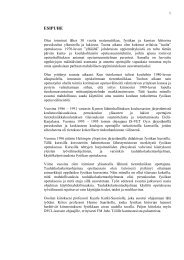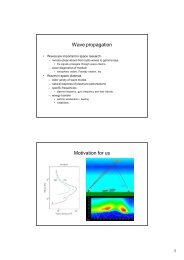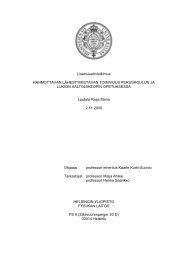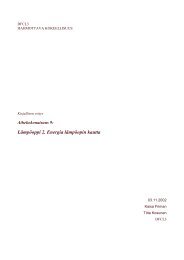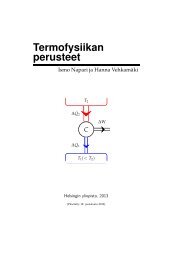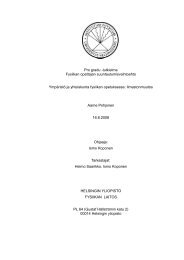Cosmological Perturbation Theory, 26.4.2011 version
Cosmological Perturbation Theory, 26.4.2011 version
Cosmological Perturbation Theory, 26.4.2011 version
You also want an ePaper? Increase the reach of your titles
YUMPU automatically turns print PDFs into web optimized ePapers that Google loves.
16 SYNCHRONOUS GAUGE 3716 Synchronous GaugeThe synchronous gauge is defined by the requirement A = B i = 0. Synchronous gauge can beused both for scalar and vector perturbations. In this section we consider only scalar perturbations,where it means thatA Z = B Z = 0. (16.1)(We use Z instead of S to denote synchronous gauge, so as not to confuse it with the scalar partof a perturbation.)One gets to synchronous gauge from an arbitrary gauge with a gauge transformation ξ µ thatsatisfiesξ 0′ + Hξ 0 = A (16.2)ξ ′ = −ξ 0 − B . (16.3)This is a differential equation from which to solve ξ 0 . Thus it is not easy to switch from anothergauge to synchronous gauge. We see that, like for comoving gauge, only the time derivative ofξ is determined.In the synchronous gauge the threads are orthogonal to the slices and the metric perturbationis only in the space part of the metric,h ij = −2D Z δ ij + 2 ( E Z ,ij − 1 3 ∇2 E Z δ ij)= −2ψ Z δ ij + 2E Z ,ij . (16.4)From Eq. (A.2), setting A = B = 0, the Christoffel symbols areΓ 0 00 = H (16.5)Γ 0 0i = Γ i 00 = 0Γ 0 ij= H [(1 − 2ψ)δ ij + 2E ,ij ] − δ ij ψ ′ + E ′ ,ijΓ i 0j= Hδ ij − δ ij ψ ′ + E ′ ,ijΓ i jk = −δ ij ψ ,k − δ ik ψ ,j + δ jk ψ ,i + E ,ijk .From Γ 0 0i = Γi 00 = 0 follows that the space coordinate lines are geodesics. Namely, the geodesicequationsẍ 0 + Γ 0 αβẋα ẋ β = ẍ 0 + Hẋ 0 ẋ 0 + Γ 0 ijẋ i ẋ j = 0 (16.6)ẍ i + Γ i αβẋα ẋ β = ẍ i + 2Γ i 0jẋ 0 ẋ j + Γ i jkẋj ẋk = 0 (16.7)are satisfied by x i = const. ⇒ ẋ i = 0 and ẋ 0 ≡ dη/dτ ≡ dt/adτ = a ⇒ dt = dτ. Thusone can construct the synchronous gauge coordinate system by choosing an initial spacelikehypersurface, distributing observers carrying space coordinate values on that hypersurface, withtheir initial 4-velocities orthogonal to the hypersurface (i.e., they are at rest with respect to thatsurface), synchronizing the clocks of the observers, and letting the observers then fall freely. Theworld lines of these observers are then the space coordinate lines and their clocks show the timecoordinate (t, not η).We use Ma & Bertschinger[2] (hereafter MB) as our main reference for synchronous gaugeand adopt from their notationh ≡η ≡−6D Z ≡ h iZiψ Z = D Z + 1 3 ∇2 E Zµ ≡ 2E Z , (16.8)


